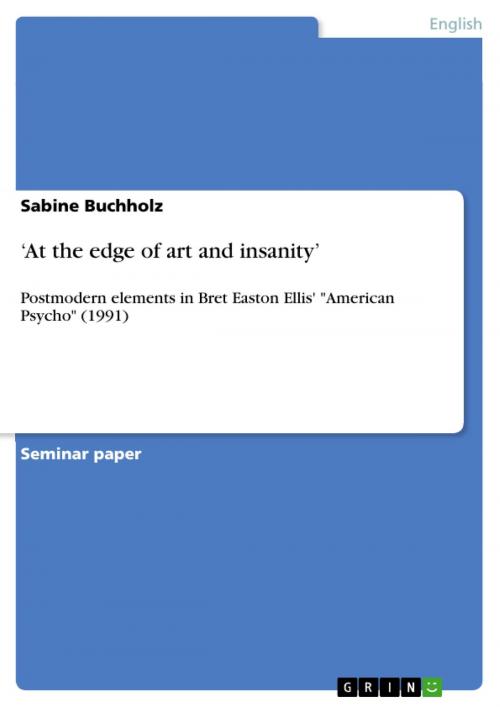'At the edge of art and insanity'
Postmodern elements in Bret Easton Ellis' 'American Psycho' (1991)
Nonfiction, Entertainment, Drama, Anthologies| Author: | Sabine Buchholz | ISBN: | 9783638898225 |
| Publisher: | GRIN Publishing | Publication: | January 24, 2008 |
| Imprint: | GRIN Publishing | Language: | English |
| Author: | Sabine Buchholz |
| ISBN: | 9783638898225 |
| Publisher: | GRIN Publishing |
| Publication: | January 24, 2008 |
| Imprint: | GRIN Publishing |
| Language: | English |
Seminar paper from the year 2006 in the subject American Studies - Literature, grade: 1,0, University of Siegen (FB 3 (Literatur-, Srach- und Medienwissenschaften)), course: 'Postmodern Fiction', 26 entries in the bibliography, language: English, abstract: With the attention-grabbing novel 'American Psycho' Bret Easton Ellis entered quite a dangerous ground. The bizarre mixture of yuppie satire and splatter horror caused reactions of scathing criticism, indignation, yes, even murder threat. As a consequence, the publishing house that had the first contract with Ellis and was supposed to edit the novel, namely Simon & Schuster, responded to this radical refusal and cancelled the deal already made. This decision, not to publish a book due to the negative responds against it, meant another scandal since it was a sensation in the American publishing business. Anyway, brushing aside all moral standards, Ellis' shocker was published in 1991 by Vintage books, and for a while, the young writer became the 'meistgehaßte[...] Autor der Welt' - evidently, because critics considered his narration too pornographic, sexist, anti-women, disgusting, boring and beyond belief. Yet, American Psycho was regarded with interest - probably last but not least because Bret Easton Ellis had been celebrated as a great talent when publishing 'Less than Zero'. Meanwhile, countless studies with many diverging approaches manifest that American Psycho may not be condemned and dismissed as a pure splatter work glorifying violence. There are works analysing the publication and the reception of the novel as well as the socio-cultural background; other studies focus on content and stylistic device , or on the motif of the serial killer as postmodern anti-hero. Additionally, some special analyses examine the position of the novel within the American history of censorship or even attempt to draw a parallel from Ellis' Bateman to Goethe's Faust. Thus, it is substantiated that the interest in 'American Psycho' has spread widely and quickly. And still, 15 years after its publication the ambiguous novel, which was, besides, brought to screen in 2000, offers many subjects of discussion. The aim of this paper is to analyse in what way and to what extent Ellis' work is distinctive for the period of literary postmodernism. Definitively, there are several innovative and scandalous stratagies applied in 'American Psycho', but are these devices really symptomatic for a postmodern perception? To answer a question like that, first of all, an essential condition is of course a definition of postmodern terms. [...]
Seminar paper from the year 2006 in the subject American Studies - Literature, grade: 1,0, University of Siegen (FB 3 (Literatur-, Srach- und Medienwissenschaften)), course: 'Postmodern Fiction', 26 entries in the bibliography, language: English, abstract: With the attention-grabbing novel 'American Psycho' Bret Easton Ellis entered quite a dangerous ground. The bizarre mixture of yuppie satire and splatter horror caused reactions of scathing criticism, indignation, yes, even murder threat. As a consequence, the publishing house that had the first contract with Ellis and was supposed to edit the novel, namely Simon & Schuster, responded to this radical refusal and cancelled the deal already made. This decision, not to publish a book due to the negative responds against it, meant another scandal since it was a sensation in the American publishing business. Anyway, brushing aside all moral standards, Ellis' shocker was published in 1991 by Vintage books, and for a while, the young writer became the 'meistgehaßte[...] Autor der Welt' - evidently, because critics considered his narration too pornographic, sexist, anti-women, disgusting, boring and beyond belief. Yet, American Psycho was regarded with interest - probably last but not least because Bret Easton Ellis had been celebrated as a great talent when publishing 'Less than Zero'. Meanwhile, countless studies with many diverging approaches manifest that American Psycho may not be condemned and dismissed as a pure splatter work glorifying violence. There are works analysing the publication and the reception of the novel as well as the socio-cultural background; other studies focus on content and stylistic device , or on the motif of the serial killer as postmodern anti-hero. Additionally, some special analyses examine the position of the novel within the American history of censorship or even attempt to draw a parallel from Ellis' Bateman to Goethe's Faust. Thus, it is substantiated that the interest in 'American Psycho' has spread widely and quickly. And still, 15 years after its publication the ambiguous novel, which was, besides, brought to screen in 2000, offers many subjects of discussion. The aim of this paper is to analyse in what way and to what extent Ellis' work is distinctive for the period of literary postmodernism. Definitively, there are several innovative and scandalous stratagies applied in 'American Psycho', but are these devices really symptomatic for a postmodern perception? To answer a question like that, first of all, an essential condition is of course a definition of postmodern terms. [...]















